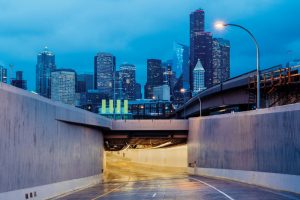Meeting Stringent Seismic and Highway Design Criteria
The Washington State Department of Transportation State Route 99 tunnel is North America’s largest-diameter bored tunnel. With a stacked roadway design, the single-bore tunnel sets a new standard for tunnel and infrastructure design, especially in dense urban areas where surface disturbance and impacts on communities, including residences and businesses, are at a premium. The completed tunnel created a safe north-south route bypassing traffic congestion in Seattle’s downtown core and improved mobility between neighborhoods. In addition, it allowed the removal of a seismically vulnerable viaduct that reduced traffic noise and opened access to the Seattle waterfront.
The General Contractor, STP, selected a 57.5-foot tunnel boring machine (TBM) and the tunnel configuration, which enhanced vehicular safety and traffic operations by providing a wide eight-foot shoulder and two 11-foot travel lanes for a 32-foot wide roadway plus a 15.5-foot vertical clearance for both upper and lower roadways.

The tunnel travels beneath more than 150 buildings in downtown Seattle, under utilities and other structures requiring protection during construction. To implement a tunneling system that provided ground support and advanced the TBM in its planned alignment, structural engineers at HNTB designed a single-pass segmental liner system. The combination of the proper operation of the TBM, placement of the precast rings, and subsequent grouting efforts to fill voids as the tunnel advanced controlled the settlement below the design threshold values resulting in no damage to existing facilities.
The use of precast concrete segmental liner, coupled with innovations in its detailing and construction, allowed the team to meet the design criteria, build to specified construction tolerances and facilitate rapid tunnel advance. A universal ring made up of 10 tapered segments was used; its placement pattern allowed adjustments at the TBM heading to keep the tunnel within the desired tolerances. Ring segments were installed inside the TBM shield with vacuum erectors and bolted up by operators with compressed air hand tools to match the previous segment. Refinements in the detailing of the segments, the size and orientation of bolt pockets, gasket placement, and grouting port locations made for a repetitive factory line-style installation of the rings. When erected behind the TBM, the rings formed a permanent watertight structure that supported roadways. Behind the completed tunnel rings, STP used an innovative system to efficiently construct the interior roadway structures. HNTB’s unique structural design fully accommodated constructability allowing STP to achieve continuous construction progress.
The large double-deck tunnel required special seismic design to sustain minimal damage, remain operational during moderate earthquakes (108-year return period), and prevent collapse by limiting inelastic deformation to acceptable levels should a rare earthquake (2,500-year return period) occur. A unique challenge was the water tightness of the tunnel lining’s radial and circumferential joints under seismic events. Joint openings caused by tunnel deformation during a critical seismic event and static loadings were magnified by required construction tolerances for gasket design; to ensure gasket satisfactory performance ‘staggering effect’ of the adjacent rings was utilized by means of shear cones and bolts. SR 99 also was the first project in the world to require cyclic testing of the tunnel lining gasket to confirm the gasket material is resilient under repetitive cyclic loading and that gasket water tightness is never compromised during and post-earthquake events. The cyclic testing requirement was specially developed to address the ‘memory effect’ concern of elastomeric gasket material.
The tunnel’s seismic performance is enhanced by custom joint design to allow relative movement between the tunnel liner and interior structures. The unique tunnel interior structure design included a series of 650-foot-long moment frame systems of walls and slabs that rest on continuous corbels, can expand and contract longitudinally independent of the tunnel rings, and accommodate relative transverse deformation between the interior structure and tunnel ring.
This project’s tunnel lining and underground structures were designed to achieve a 100-year design service life. The concrete mix was designed to deliver dense and relatively impervious concrete to overcome the effects of moderately aggressive soils, the use of chlorides in roadway deicing chemical, and carbon dioxide and moisture of the tunnel operating environment (which lowers the pH level in concrete and accelerates the rate of reinforcement corrosion). To this effect, low water/cementitious material ratio and non-reactive aggregates were used; Portland cement was partially replaced with fly ash and micro silica. Rebar covers were determined through a comprehensive concrete durability study and models calibrated for 100-year design life. A waterproofing system encapsulated the cut-and-cover structure and expansion joints of approach structures. All interior tunnel superstructures, joints, and bearings are fully accessible for inspection and maintenance and detailed for future periodic replacement.
The SR 99 Tunnel is designed as one of the safest tunnels worldwide. The structural design meets both stringent seismic and highway design criteria. As a result, tunnel systems will function during and after a design earthquake to control a fire, evacuate smoke, allow people to exit safely, and maintain structural integrity.■
